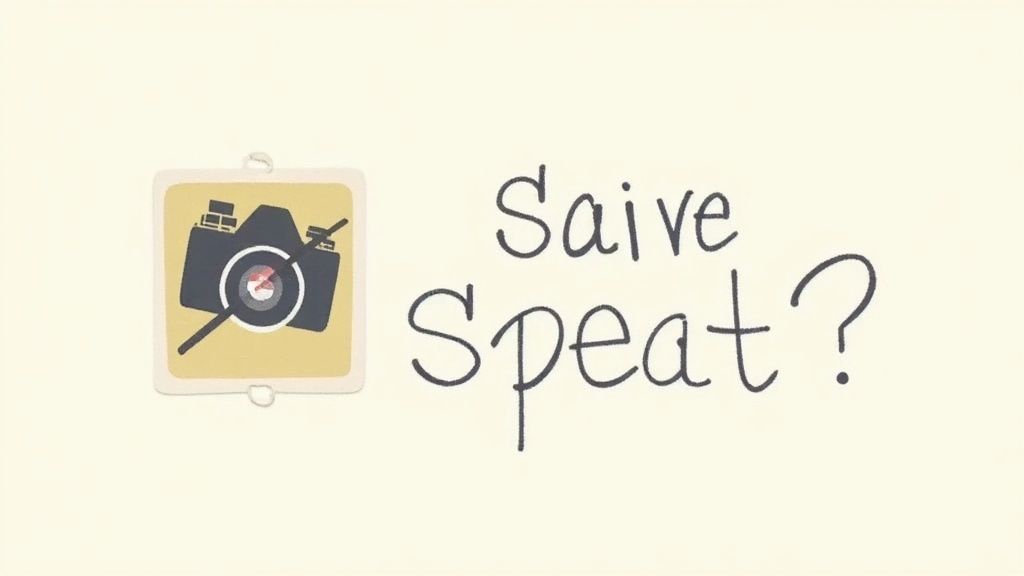7 Powerful Presentation Design Tips for 2025

In a content-saturated world, a standard presentation no longer captures attention; it gets lost in the noise. The key to engagement now lies in dynamic, visual storytelling, especially through formats like social media carousels. This article moves beyond generic advice to provide you with a curated list of actionable, expert-level presentation design tips. We'll explore how to transform your ideas into compelling visual narratives that resonate deeply with your audience.
This guide is designed for immediate application. You will learn seven core strategies, from establishing a clear visual hierarchy to mastering data visualization, that will elevate your content from simple slides to impactful stories. We will also demonstrate how to implement these principles using AI-driven tools like Lumeo, which helps turn any text into stunning carousels for platforms like LinkedIn and Instagram. By mastering these techniques, you can build a powerful digital presence and drive meaningful engagement. To truly embrace dynamic storytelling, staying updated with emerging AI image generation trends can also significantly elevate your visual content. Let's dive into the strategies that will sharpen your visual communication game.
1. One Idea Per Slide
The "One Idea Per Slide" principle is a cornerstone of effective presentation design, championed by visionaries like Steve Jobs and presentation expert Nancy Duarte. This approach dictates that each slide in your presentation should communicate a single, focused concept. By dedicating one slide to one core message, you prevent cognitive overload, ensuring your audience can fully absorb and retain each point before moving to the next. This method transforms your presentation from a dense document into a clear, compelling narrative.

This powerful technique forces you to distill your message down to its essence, making it a vital presentation design tip for anyone creating carousels or slide decks. Instead of confronting your audience with a wall of text and multiple data points, you guide them through a logical, step-by-step journey.
Why This Method Works
The human brain can only process a limited amount of new information at once. When a slide is cluttered with multiple ideas, bullet points, and images, the audience's attention becomes divided. They are forced to decide what is most important, often missing the main takeaway. A single-idea slide eliminates this friction, directing focus and enhancing comprehension and recall. This clarity is precisely why it's a favored technique in high-stakes environments, from TED stages to Apple's iconic product launches.
How to Implement "One Idea Per Slide"
Applying this principle requires discipline and a clear understanding of your core message. Here are actionable steps to integrate it into your workflow, especially when using a tool like Lumeo to generate your carousel content:
- Deconstruct Your Topic: Start by outlining your entire presentation. Break down your primary subject into the smallest individual ideas or logical steps. Each of these will become a separate slide.
- Craft a Strong Headline: Use the slide title as the core idea. The headline should be a complete, declarative sentence that summarizes the slide's entire purpose. For example, instead of "Sales Growth," use "Our sales grew by 25% in Q3."
- Use Visuals as the Focus: Let a single, powerful image, chart, or a short video clip be the hero of the slide. Any accompanying text should only serve to support or briefly explain the visual, not compete with it.
- Sequence for Storytelling: Arrange your single-idea slides in a logical sequence that tells a coherent story. Ensure smooth transitions connect each point, building upon the last to create a compelling narrative arc. You can dive deeper into the fundamentals of how to create effective presentation slides here.
2. Consistent Visual Hierarchy
A consistent visual hierarchy is the deliberate organization of design elements to guide the audience's eye through information in order of importance. Popularized by top consulting firms like McKinsey and design agencies such as IDEO, this principle uses size, color, contrast, and positioning to create a predictable and professional structure. By establishing a clear visual path, you make your content easier to scan and understand, which significantly boosts comprehension and perceived professionalism.

This systematic approach is one of the most crucial presentation design tips for creating a cohesive experience, especially across a multi-slide carousel. It ensures that your audience instinctively knows where to look for key information, such as titles, data points, and conclusions, without having to reorient themselves on every slide. This consistency builds trust and reinforces your message's authority.
Why This Method Works
The brain seeks patterns to conserve energy. When your slides follow a consistent visual structure, the audience doesn't waste mental effort figuring out the layout each time. This cognitive ease allows them to focus entirely on your message. Inconsistency, on the other hand, creates visual noise and friction, forcing the brain to work harder and potentially distracting from the core content. This is why corporate brand presentations and university lecture decks rely heavily on standardized templates.
How to Implement a Consistent Visual Hierarchy
Enforcing visual consistency requires setting up rules before you begin designing. This discipline ensures every slide feels like part of a unified whole. Here are actionable steps for applying this principle:
- Create a Master Template: The most effective way to ensure consistency is to establish a master slide or template. Define fixed positions for your logo, slide numbers, titles, and main content areas. This becomes the foundation for your entire presentation.
- Establish a Typographic Scale: Use a consistent set of font sizes. For example, your main heading might be 32pt, subheadings 24pt, and body text 16pt. Stick to these sizes religiously throughout the deck.
- Define Your Color Palette: Assign specific roles to colors. Use one color for all primary headlines, another for key data points, and a neutral color for body text. This helps create a visual language your audience can quickly learn.
- Maintain Uniform Spacing: Be meticulous with margins, padding, and the space between elements. Consistent alignment and spacing create a clean, organized look that signals professionalism and attention to detail. This is a subtle but powerful aspect of effective presentation slide design.
3. High-Quality Visuals Over Text
Prioritizing high-quality visuals over dense text is a transformative presentation design tip that leverages a fundamental truth: the human brain processes images 60,000 times faster than text. This principle, championed by visual communication experts like Garr Reynolds in his "Presentation Zen" methodology, advocates for using compelling photography, illustrations, and data visualizations to communicate the core message, with text playing a supporting role. Instead of describing a concept, you show it, making your message more immediate, emotional, and memorable.

This approach is highly effective for carousels and slide decks because visuals create an instant connection and convey complex ideas with elegant simplicity. Think of National Geographic's iconic use of stunning photography to tell powerful stories or Airbnb's pitch decks that used lifestyle imagery to sell an experience, not just a service. These examples prove that a single, well-chosen image can be more persuasive than a paragraph of text.
Why This Method Works
Visuals tap directly into the brain's emotional and long-term memory centers. When an audience sees a powerful image, they don't just understand the information; they feel it. This emotional resonance significantly boosts engagement and retention. A slide with a powerful photograph or a clear chart communicates its point almost instantaneously, whereas a text-heavy slide requires conscious effort to read and decipher. This visual-first strategy reduces cognitive load and keeps your audience focused on your narrative.
How to Implement "High-Quality Visuals Over Text"
Effectively adopting a visual-first approach means curating images that are both high-quality and highly relevant. Here are actionable steps to elevate your presentations:
- Source Strategically: Utilize reputable stock photo sites like Unsplash, Pexels, or Shutterstock for professional-grade images. Ensure any visual you choose is high-resolution (at least 300 DPI) to appear crisp on all screens.
- Ensure Relevancy: The visual must directly support and enhance the slide's core idea. A beautiful but irrelevant image will only confuse your audience. For example, use a photo of a specific target demographic for a marketing pitch, not a generic office photo.
- Avoid Clichés: Steer clear of staged, inauthentic stock photos that feel impersonal. Look for images that feel genuine and align with your brand's voice.
- Create Custom Graphics: For unique concepts or data, consider creating your own simple charts, icons, or illustrations. You can discover more strategies for effective visual content creation here.
4. Strategic Use of White Space
The strategic use of white space, often called negative space, is a fundamental presentation design tip that separates amateur designs from professional ones. Popularized by the minimalist philosophies of Apple and the Swiss design movement, this principle involves intentionally leaving areas of your slide empty. Far from being "wasted space," white space acts as a powerful tool to guide the viewer's eye, reduce clutter, and give your core message room to breathe.

This approach enhances readability and lends an air of sophistication and confidence to your presentation. Instead of overwhelming your audience with information, you are deliberately focusing their attention on what truly matters. This creates a more relaxed and impactful viewing experience, making your key points more memorable.
Why This Method Works
A cluttered slide forces the brain to work harder to identify important information, leading to cognitive strain and a higher chance that your message will be lost. White space counteracts this by creating visual hierarchy and separation between elements. It signals to the audience which elements are most important by giving them prominence. Designs that use ample white space, like those in high-end fashion or architectural presentations, feel more elegant, modern, and easier to comprehend, directly improving audience engagement and retention.
How to Implement "Strategic Use of White Space"
Mastering white space is about resisting the temptation to fill every pixel. It requires a deliberate and thoughtful approach to composition, especially when designing carousels where clarity is paramount. Here's how to apply it effectively:
- Treat Space as an Active Element: Don't view white space as the leftover area. Instead, consider it a critical component of your design that defines and frames your content.
- Increase Margins and Padding: Give your text and images generous breathing room. Increase the space between lines of text (leading) and around key visuals to prevent a cramped feeling.
- Emphasize with Emptiness: To make a headline, a statistic, or an image stand out, surround it with a significant amount of white space. The emptiness naturally draws the eye toward the isolated element.
- Follow the Rule of Thirds: Position your most important content along the lines or at the intersections of a 3x3 grid. This naturally creates a balanced composition with functional white space. Using a tool like Lumeo, you can easily adjust element placement to achieve this balance.
5. Limited Color Palette Strategy
A limited color palette strategy is a fundamental presentation design tip that involves using a restricted range of colors, typically two to four, to create a cohesive and professional look. This disciplined approach prevents visual chaos and enhances brand recognition, as seen in IBM's signature blue-dominant presentations or Spotify's iconic use of green and black. By sticking to a predefined set of colors, you guide the audience's attention intentionally and reinforce your message without distraction.
This technique is rooted in the principles of Swiss design and Google's Material Design, which prioritize clarity and function. Limiting your colors creates a strong visual identity and makes your content appear more polished and deliberate. It transforms a simple slide deck into a branded, memorable experience, ensuring every slide feels connected to the next.
Why This Method Works
Color overload can be just as detrimental as text overload, causing cognitive strain and diluting your core message. A limited palette establishes a clear visual hierarchy, helping the audience subconsciously understand the structure and importance of different elements on the slide. This strategic use of color taps into psychological associations, building trust with calming blues in a medical presentation or conveying energy with a vibrant accent color. The result is a more focused, aesthetically pleasing, and impactful presentation.
How to Implement a Limited Color Palette Strategy
Adopting this strategy requires thoughtful planning, but modern tools make it accessible for everyone. Here’s how to effectively integrate it into your presentation design workflow:
- Apply the 60-30-10 Rule: Structure your palette for balance. Use a dominant, primary color for 60% of your design (like backgrounds), a secondary color for 30% (for content areas or highlights), and a vibrant accent color for the final 10% (for calls-to-action or key data points).
- Prioritize Brand Consistency: If you are representing an organization, always start with its official brand colors. This reinforces brand identity and ensures your presentation aligns with all other marketing materials.
- Generate and Test Palettes: To help implement a limited color palette strategy effectively, you might find a tool like a color palette generator useful. Use tools like Adobe Color or Coolors.co to discover harmonious combinations, and always test them for sufficient contrast to ensure readability for all audience members.
- Understand Color Psychology: Choose colors that evoke the desired emotional response for your topic. For a deeper dive into creating effective color schemes, you can learn more about using split complementary colors here.
6. Data Visualization Best Practices
Data visualization is the art of translating complex data into a visual context, making it easier for the human brain to understand and act upon. Pioneered by experts like Edward Tufte and popularized by storytellers like Hans Rosling, this approach transforms raw numbers into compelling visual narratives. Instead of just presenting data, you guide your audience to an insight, making it one of the most crucial presentation design tips for impactful communication.
Effective data visualization isn't just about making charts look pretty; it’s about choosing the right visual format to tell the most accurate and clear story. A well-designed chart can reveal trends, patterns, and outliers that a simple spreadsheet would obscure, turning abstract figures into tangible, memorable takeaways.
Why This Method Works
Our brains are hardwired to process visual information far more efficiently than text or numbers. When you present data visually, you tap into this innate ability, reducing cognitive load and accelerating comprehension. A single, well-crafted chart can communicate a key finding more effectively than a paragraph of explanation. This is why leading organizations like McKinsey and The New York Times rely on powerful visualizations to convey complex financial and societal data with clarity and authority.
How to Implement Data Visualization Best Practices
Turning data into a clear story requires careful thought and adherence to established principles. Follow these actionable steps to create visuals that inform rather than confuse:
- Select the Right Chart Type: The story you want to tell dictates the chart you should use. Use bar charts for direct comparisons, line charts to show trends over time, pie charts for parts of a whole (sparingly), and scatter plots to reveal relationships between variables.
- Simplify for Clarity: Remove anything that doesn't add informational value. This includes eliminating unnecessary gridlines, borders, shadows, and 3D effects. Every element should serve a purpose in enhancing understanding.
- Use Color Strategically: Don't use color for decoration. Use it to highlight key data points, group related information, or create a visual hierarchy. Stick to a limited, brand-aligned color palette to maintain consistency and avoid overwhelming your audience.
- Ensure Data Integrity: Start your Y-axis at zero for bar charts to avoid misleading representations of magnitude. Always cite your data sources to build credibility and allow for verification. Label your axes clearly and provide context with a concise, descriptive title.
7. Readable Typography Guidelines
Typography is the art and technique of arranging type to make written language legible, readable, and appealing when displayed. In presentation design, readable typography guidelines are not just about choosing a pretty font; they are a systematic approach to ensuring your message is communicated clearly and effectively. This involves the careful selection of fonts, sizes, spacing, and hierarchy to guarantee maximum legibility across different devices and viewing conditions, from a smartphone screen to a large projection.
Effective typography acts as the voice of your written content. Just as a speaker's tone can influence an audience, your font choices and text formatting guide the viewer's eye and shape their perception of your message. This is why major brands like Google, with its custom Product Sans, and Microsoft, with its ubiquitous Calibri and Segoe UI, invest heavily in typography for their corporate presentations. Following established guidelines is one of the most crucial presentation design tips for creating a professional and accessible experience.
Why This Method Works
The primary goal of any presentation is communication. If your audience has to squint or struggle to decipher your text, your message is lost before it's even processed. Readable typography reduces cognitive load, allowing the audience to focus on understanding the content rather than decoding it. Well-chosen fonts create a clear visual hierarchy, signaling what is most important and how different pieces of information relate to each other. Adhering to accessibility standards like the WCAG contrast ratios also ensures your presentation is inclusive and can be understood by people with visual impairments.
How to Implement Readable Typography
Integrating professional typography into your presentations is straightforward with a few key principles. This is especially important when using a tool like Lumeo to generate carousels, as text needs to be instantly legible on smaller screens.
- Choose Legible Fonts: Stick to clean, simple sans-serif fonts like Helvetica, Arial, or Calibri for body text. These fonts are designed for screen readability and are reliably displayed across most devices. Reserve more decorative or complex fonts for headlines, and only if they remain clear.
- Establish a Clear Hierarchy: Use size, weight (bold), and color to differentiate between titles, subtitles, and body text. A common practice is to make your main title significantly larger than your body text (e.g., 32pt title, 18pt body) to create an obvious visual order.
- Prioritize Contrast and Spacing: Ensure your text has a high contrast ratio against its background, aiming for at least a 4.5:1 ratio for accessibility compliance. Increase line spacing (leading) to about 1.25-1.5x the font size to improve readability and prevent text from feeling cramped.
- Limit Line Length: For optimal readability, keep lines of text relatively short, around 6-8 words per line. Long lines of text are difficult for the eye to track from one to the next, causing fatigue. This is a critical consideration for carousel slide design.
7 Key Presentation Design Tips Comparison
| Aspect | One Idea Per Slide | Consistent Visual Hierarchy | High-Quality Visuals Over Text | Strategic Use of White Space | Limited Color Palette Strategy | Data Visualization Best Practices | Readable Typography Guidelines |
|---|---|---|---|---|---|---|---|
| Implementation Complexity 🔄 | Moderate 🔄 | High 🔄 | High 🔄 | Moderate 🔄 | Moderate 🔄 | High 🔄 | Moderate 🔄 |
| Resource Requirements ⚡ | Low to Moderate ⚡ | Moderate ⚡ | High ⚡ | Low to Moderate ⚡ | Low to Moderate ⚡ | Moderate to High ⚡ | Low to Moderate ⚡ |
| Expected Outcomes 📊 | Clear focus and better retention 📊 | Professional look and guided attention 📊 | Enhanced engagement and memory 📊 | Improved readability and aesthetic 📊 | Cohesive branding and consistency 📊 | Clear, credible data insight 📊 | High legibility and comprehension 📊 |
| Ideal Use Cases 💡 | Complex ideas needing clarity 💡 | Corporate & academic presentations 💡 | Storytelling & emotionally rich content 💡 | Minimalist, sophisticated designs 💡 | Brand-aligned and accessible palettes 💡 | Data-driven presentations 💡 | Any presentation with significant text 💡 |
| Key Advantages ⭐ | Simplifies message, reduces overload ⭐ | Builds credibility, predictable flow ⭐ | Boosts engagement, transcends language ⭐ | Reduces clutter, highlights key points ⭐ | Consistency, reduces design fatigue ⭐ | Makes complex data digestible ⭐ | Ensures readability across devices ⭐ |
Start Creating High-Impact Visuals Today
We’ve journeyed through seven foundational principles designed to elevate your visual content from ordinary to unforgettable. From the discipline of focusing on one powerful idea per slide to establishing a clear visual hierarchy, these aren't just abstract theories. They are practical, actionable strategies that form the bedrock of compelling communication.
Mastering these concepts means you are no longer just sharing information; you are crafting an experience. By prioritizing high-quality visuals over dense text, strategically using white space, and adhering to a limited color palette, you create a seamless and professional aesthetic. This foundation of strong visual storytelling makes your message not only easier to understand but also significantly more persuasive and memorable. These are the presentation design tips that separate amateur content from professional, high-impact assets.
From Theory to Actionable Practice
The true value of these presentation design tips emerges when you put them into practice. The next time you begin a project, consciously apply these rules. Start by outlining your narrative, ensuring each slide or carousel card communicates a single, focused point. Then, build your visual language with intention.
- Audit Your Typography: Is your font choice readable and consistent? Are you using size and weight to guide the viewer’s eye effectively?
- Evaluate Your Color Choices: Does your palette support your brand and message without overwhelming the senses?
- Scrutinize Your Data: Are your charts and graphs simple, clear, and instantly understandable, or are they cluttered with unnecessary details?
Answering these questions for every piece of content you create will build the habits necessary for consistent excellence. You'll begin to see design not as a decorative afterthought, but as an integral part of your message's success.
Empower Your Workflow with the Right Tools
Consistently applying these principles can feel daunting, especially when facing tight deadlines. This is where modern tools become indispensable. Instead of starting from a blank canvas every time, you can leverage platforms designed to embed these best practices directly into your workflow.
For instance, finding unique, high-quality images is often a major bottleneck. To help you start creating your own unique visuals instantly, consider using a free AI image generator. This allows you to generate custom graphics that perfectly match your specific content needs, ensuring your visuals are both original and impactful. By integrating such tools, you can focus more on the strategic message while the technology handles the heavy lifting of design execution.
Ultimately, mastering presentation design is about taking control of your narrative. It’s about ensuring your brilliant ideas are seen, understood, and felt. Stop letting poor design undermine your message. Embrace these proven tips, empower your content with the right tools, and start building the powerful, professional digital presence you and your brand deserve.
Ready to put these principles into action without the steep learning curve? Lumeo is designed to help you create stunning, on-brand presentations and carousels in minutes. Its AI-powered platform and customizable Brand Kits make implementing these expert presentation design tips effortless, so you can focus on what you do best: sharing your message.